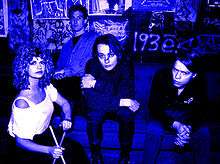Danceteria
Danceteria was a four-floor nightclub located in New York City, which operated from 1979 until 1986 (and in the Hamptons until 1995). Throughout its history, the club had seven different locations, three in NYC and four in the Hamptons. The second, most famously at 30 West 21st Street in Manhattan, served as the location for the disco scene in the film Desperately Seeking Susan.
History
The first Danceteria was opened at 252 West 37th Street by German expatriate Rudolf Pieper and talent booker Jim Fouratt.[1] It catered to a diverse after-hours crowd coming from the downtown rock clubs Mudd Club, Trax, TR3, Chinese Chance and CBGB, and gay discos.[1] The club's DJs were Bill Bahlman, Mark Kamins and Sean Cassette.[1] Bahlman played the first floor on Thursdays and Saturdays, and the second floor every Friday. Kamins played the second floor on Saturday nights. This facility was closed by the New York police and fire departments in 1980 as it was an illegal, unlicensed facility. Kamins credited the first Danceteria with being the first club to play videos and have two separate DJs play for 12 straight hours. The first Danceteria Video Lounge was designed by video artists John Sanborn and Kit Fitzgerald, who programmed an eclectic mix of found footage, video art, early music videos and musical performances.[2][3]

In 1982, John Argento hired Fouratt and Pieper to promote and book the talent at a new six-floor facility, which became the noted 21st Street Danceteria. The club opened to massive crowds and critical acclaim.[4] The regular DJs on the main dance second floor were Mark Kamins on Saturday nights and Bill Bahlman on Thursdays and Fridays. Other DJ's on the second floor included Louis Martinez, who had cameos at places like Studio 54, Lolo, Richard Sweret, and Jody Kurilla. Bill Bahlman, Richard Sweret and Randa Relich Milliron ran the Experimental First Floor serving as both DJs and VJs during the club's first months of operation until Fouratt's ousting; former Mudd Club DJ Anita Sarko spun on the first floor, where the bands performed, as well as in the VIP room, Congo Bill, for special events. The Video Lounge was located on the third floor of the new space and Ben Salzman & Jessica Jason, continued the artistic quality of the Video Lounge. Danny Cornyetz made videos of some of the acts with the fixed ceiling camera that piped what was going on on the 1st floor stage throughout the club.
Three months after opening, Argento and Pieper dismissed Fouratt and hired Ruth Polsky as the club's talent booker. Under Polsky's direction, the club became renowned as one of centers of new wave music in New York and was frequented by many musicians and artists who became famous during the decade, such as Madonna, New Order, Duran Duran, Billy Idol, Sade, Wham!, the Smiths, Squeeze, Cyndi Lauper, Jean-Michel Basquiat, Keith Haring, Run-DMC, Depeche Mode, Butthole Surfers, The Fall, the B-52's, Samhain, Bauhaus, RuPaul, Berlin, the Units, Romeo Void, Sonic Youth, Swans, Nick Cave and the Bad Seeds, the Cult, Karen Finley, Violent Femmes, Soft Cell, the Jesus and Mary Chain, Beastie Boys, LL Cool J and Rob Zombie.[5][6]
Famed New York City doorman Haoui Montaug worked as a doorman at Danceteria.[7]
In 1984, Argento and Pieper opened a successful Hamptons outpost of Danceteria in Water Mill, New York. This was the first trendy NYC-style nightclub to open in the Hamptons.
The third Danceteria operated from 1990 to 1993 in a run-down midtown space, the Martha Washington Hotel at 30 East 30th Street. Kamins, Johnny Dynell, Walter V and Danceteria veteran Freddy Bastone were the DJs at this facility, also during this time NJ rock band Spare Change performed regularly on the main stage, usually inciting riots with their raw brand of rock music. Club Kid Goldy Loxxx DJed on the opening night in the lounge room, and for the first few Friday nights (along with Kamins) in the main room, one of the first times a club personality was chosen to spin.
The 21st Street location was sold, to be converted to luxury condominiums, slated to open in 2009.[5]
References
- Zeger, Barry. Liner notes of Just Can't Get Enough: New Wave Dance Hits of the '80s (1997) Rhino R2 72586.
- Lewis, Steve (28 November 2013). "Legendary DJ & Producer Mark Kamins Has Passed Away". Blackbook Magazine. New York. Retrieved 15 June 2017.
- Post, Henry (3 May 1982). "Heart Of Darkness". New York Magazine. New York: New York Magazine LLC. Retrieved 15 June 2017.
- Bradshaw, Daniel (2016). Discotecture: An Investigation Into the Symbiosis of Habitat and Habitas. Lulu Press, Inc. ISBN 9781326516277.
- Abelson, Max (20 May 2008). "This Used to Be Madonna's Playground: Danceteria to Become Luxury Condos". Observer. Retrieved 15 June 2017.
- O'Brien, Lucy (2 September 2007). "Madonna: For the First Time, Her Friends and Lovers Speak Out". The Independent. Retrieved 15 June 2017.
- "Haoui Montaug; Disco Doorman, 39". The New York Times. NYTimes Co. 12 June 1991. Retrieved 15 June 2017.